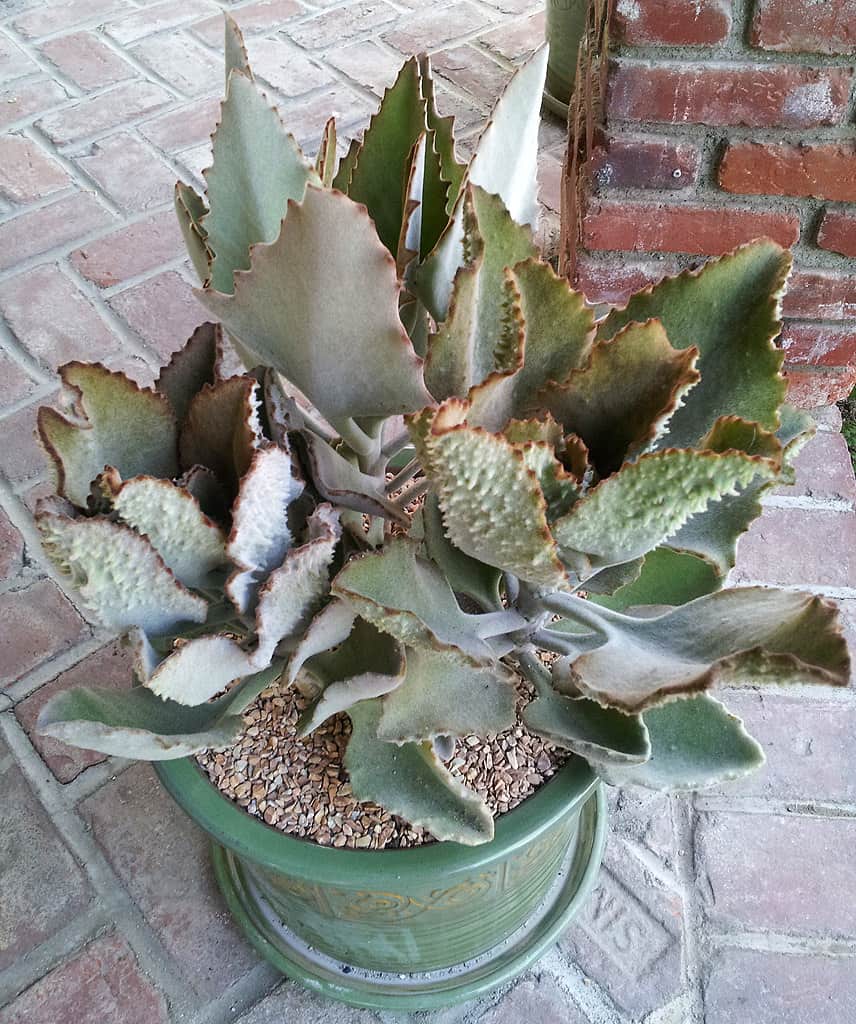Kalanchoe beharensis “Fang” is a cultivar of the species Kalanchoe beharensis much appreciated in collections around the world for the beauty of its foliage.
It is recommended for people with little experience in the culture of crass due to its high resistance.
This cultivar is characterized by forming a small shrub no more than 2 meters tall with somewhat thick stems that become woody in larger plants.
In principle, the plant develops a unique central stem that can branch when it exceeds 30 cm in height.
The stems have a greenish-brown color and are covered with numerous gray hairs very conspicuous.
Numerous brown scars are seen on the stems when the leaves fall off.
The leaves are the main attraction of the plant for its color and shape. They are arranged opposite on the stems, they are very fleshy, they have a very conspicuous petiole, they measure approximately 8 cm long, they have a spatulated (triangular) shape with very irregular and sawn margins, they are covered with numerous gray hairs that form a wool throughout the surface, are green with brown spots on the margins, are folded in its central middle area forming a V and have numerous fleshy evaginations similar to teeth or spines in the upper middle region of the underside.
The flowers are not very attractive but they also provide an ornamental value.
These are arranged in apical inflorescences in panicle that develop a floral stem of approximately +/- 25 cm in height.
The flowers are small and have yellowing with reddish stripes. The floral corolla is shaped like a bell with rounded petals.
Tips to take care of the Kalanchoe Beharensis “Fang”
The Fang or Stalactite plant is very easy to maintain in the garden and can be grown both indoors and outdoors.
Illumination
It grows efficiently in brightly lit interiors; its ideal location is in full sun always protecting it from the strong summer sun.
Thanks also for some hours of partial shade during the day. The intense summer sun can cause burns to the leaves.
Temperature
Fresh to warm for better growth and optimal health. Its optimum range should range between 15-30 ° C.
Temperatures below 0 ° C can cause foliage to fall and root and stem rot. Tolerates short and soft frosts.
Substratum
It needs to grow in soil poor in organic matter with optimal drainage and aeration.
Thanks to developing on rocky substrates with little soil; if we use substrates for crass plants we can incorporate a layer of gravel or coarse sand.
Irrigation Frequency
Water deeply in warm times after the substrate dries completely.
In winter the irrigation should be more spaced to avoid that the combination of the wet and cold substrate cause rot.
Plagues and diseases
Very attacked by mealybugs and rarely by aphids. The mealybugs are mainly housed in the plant stem. Fungi can rot the roots if the soil stays moist for a long time.
Multiplication
Very simple from cuttings of stems of more than 10 cm in length or by cuttings of leaves. The leaves take about 3 weeks to form roots.
Conclusion
The name “beharensis” refers to the southern area of Madagascar called Behara, the origin of this Crass plant belonging to the Crassulaceae family.
The Kalanchoe de Behara is a crass plant that can reach 3 meters high and has a thin stem, almost without branches. Its large leaves are fleshy and opposite, triangular in shape and covered with velvet.
I suggest you get one of this plant you will love it.
